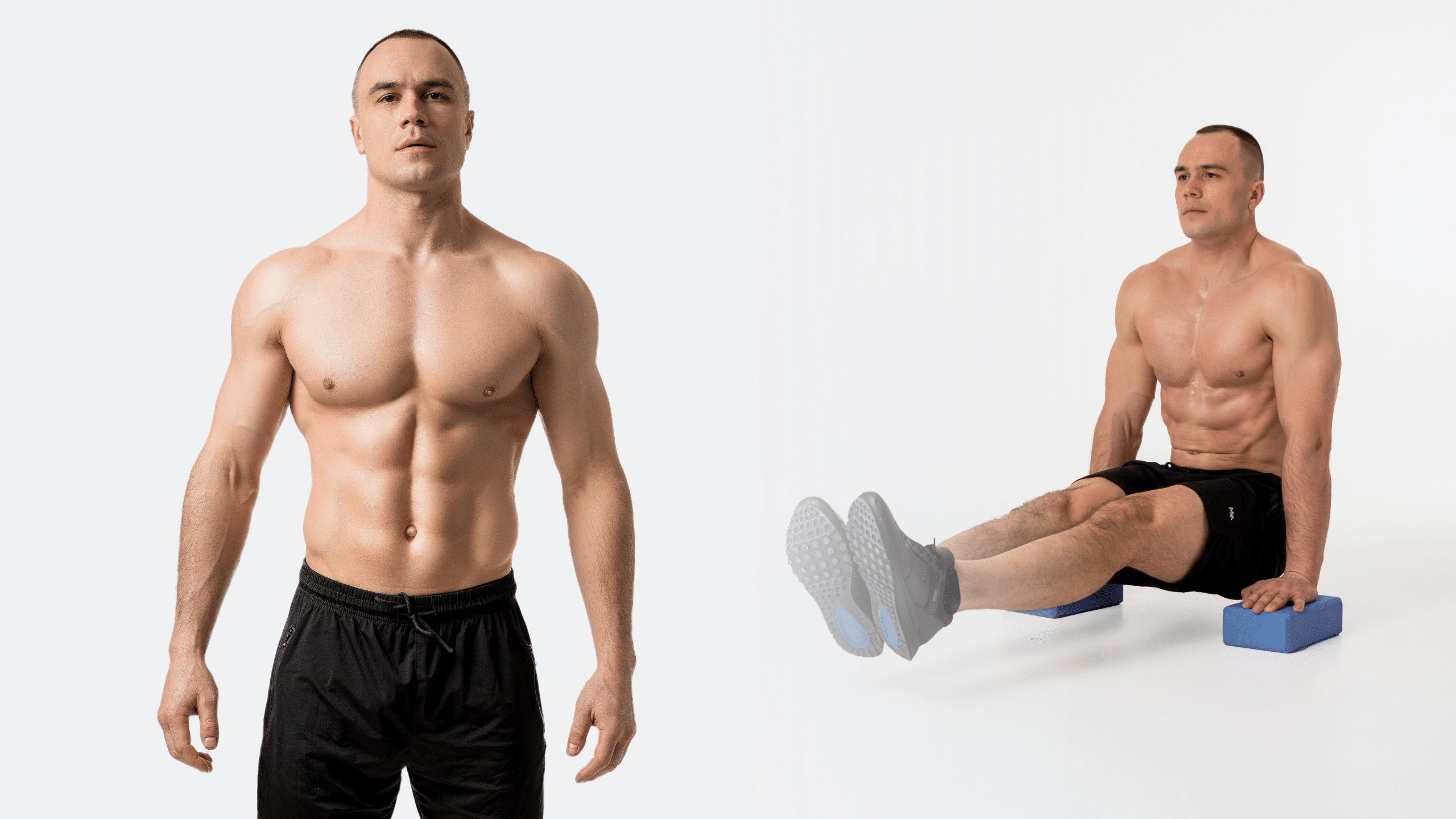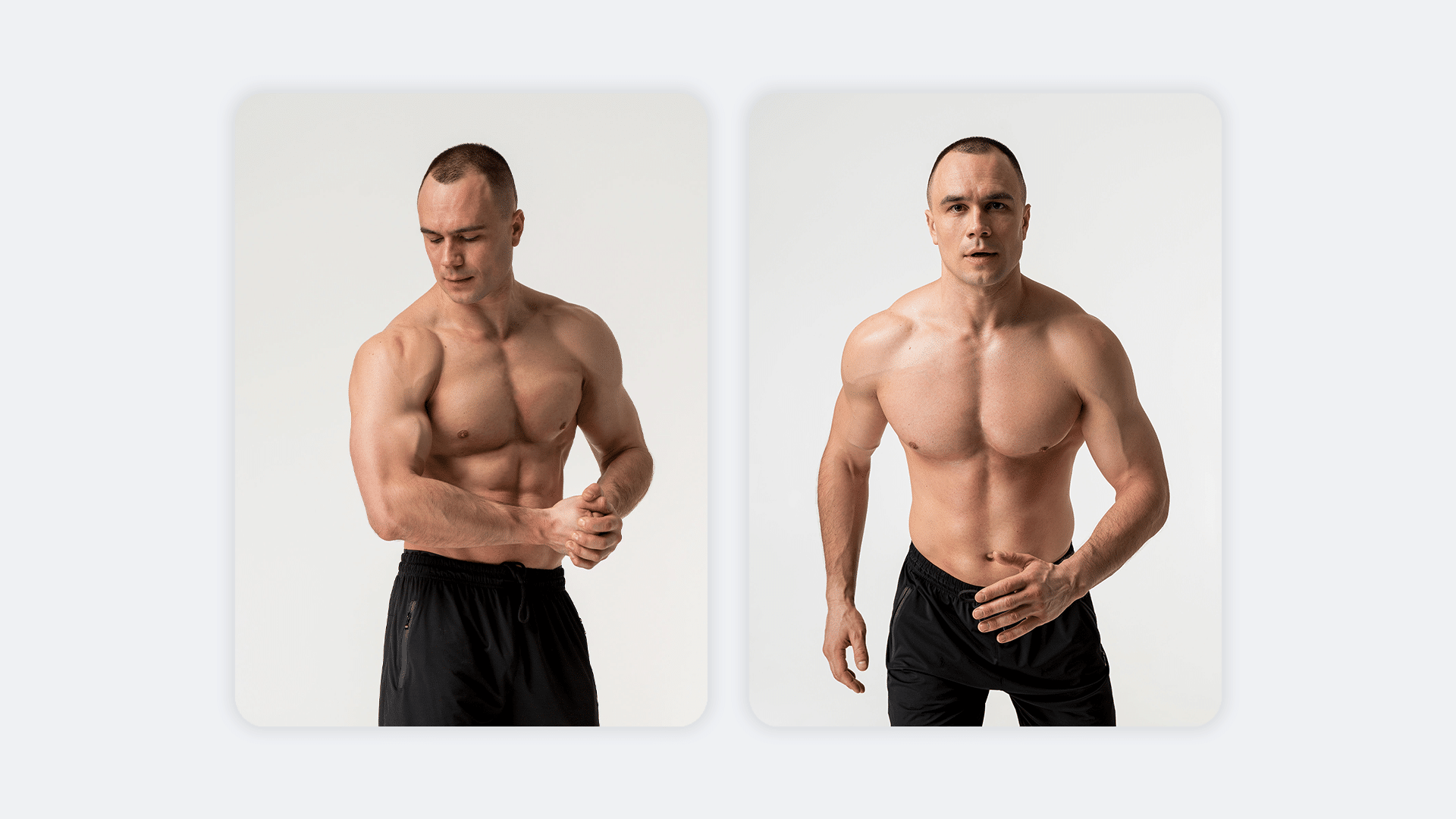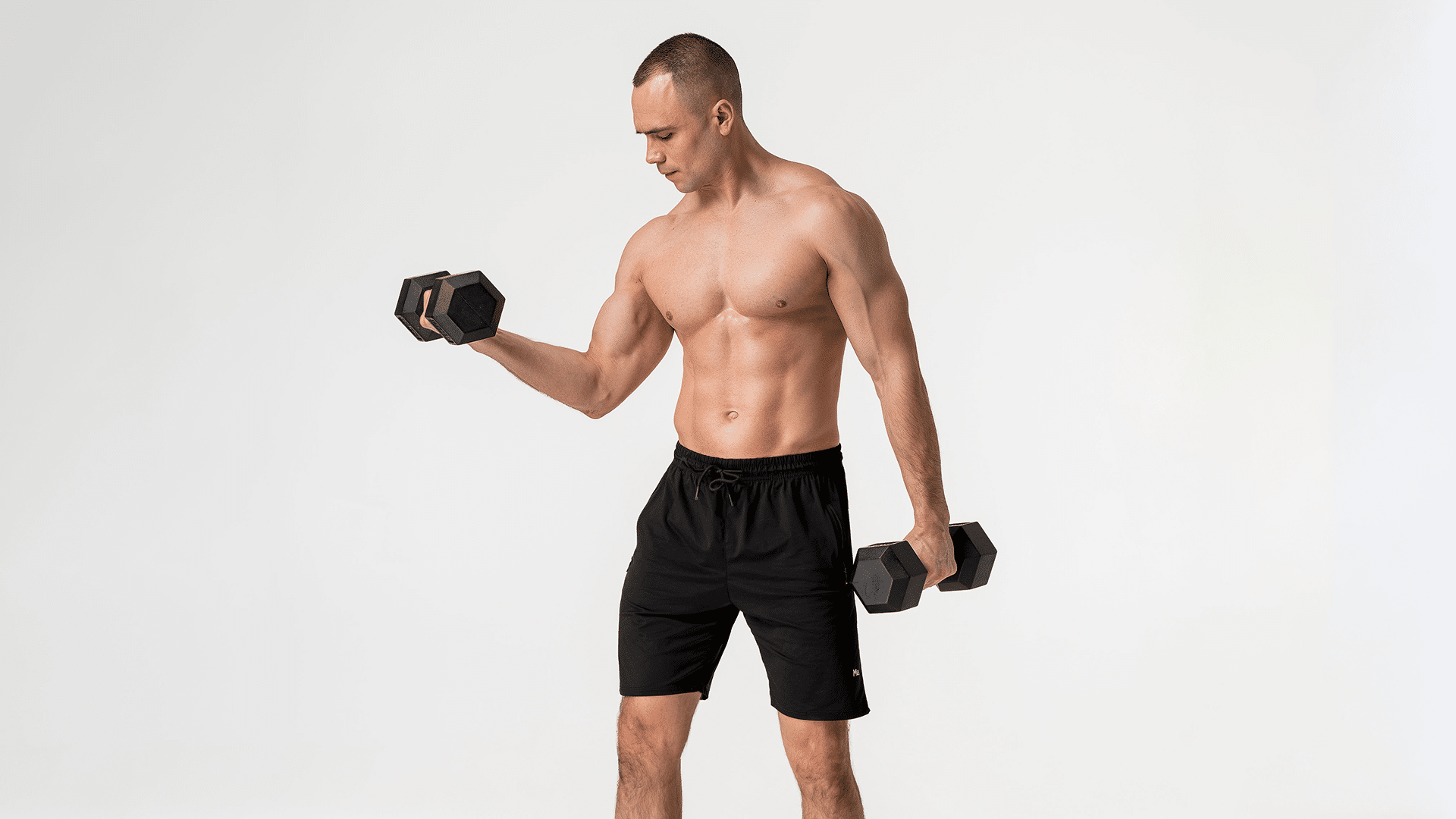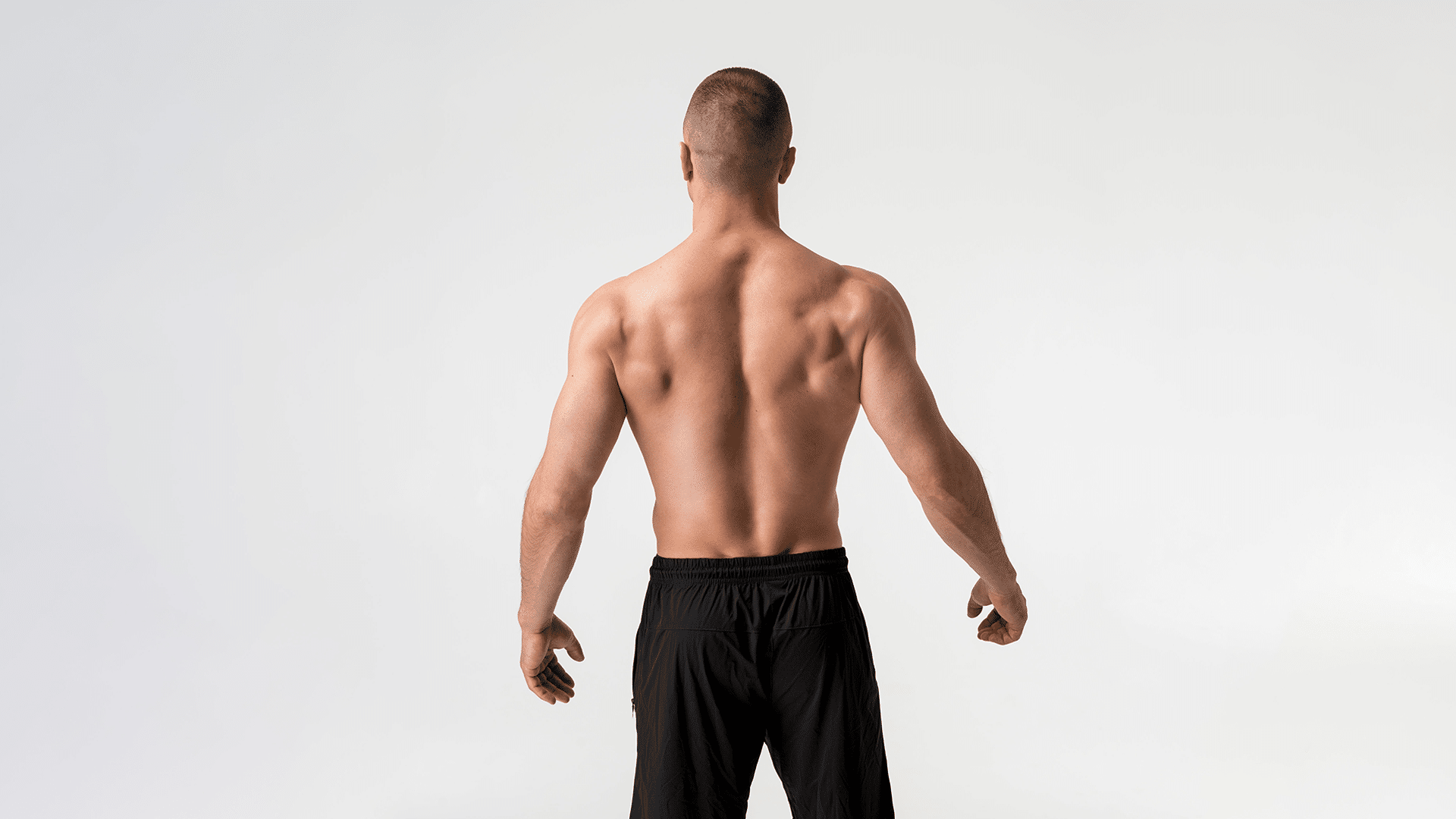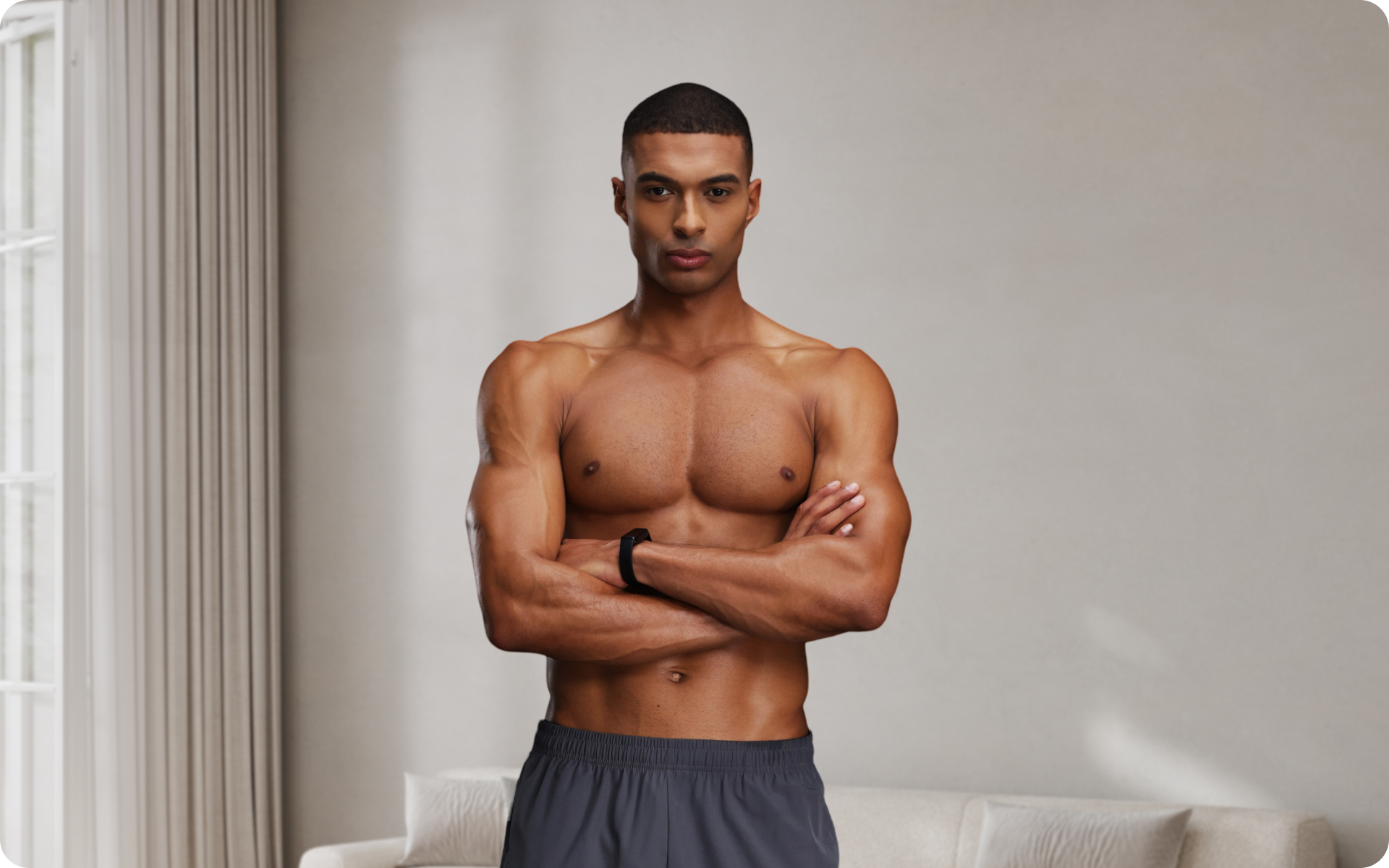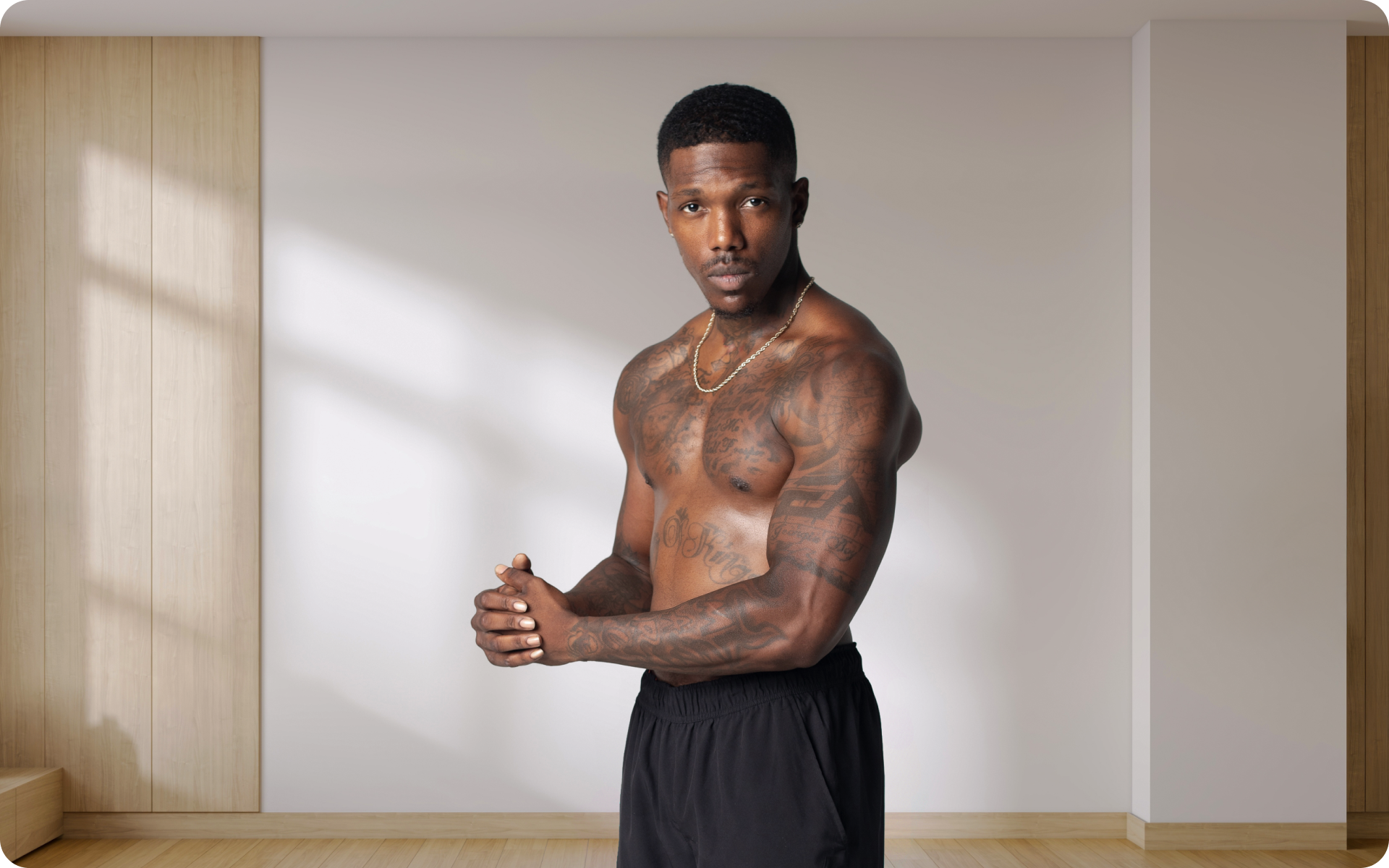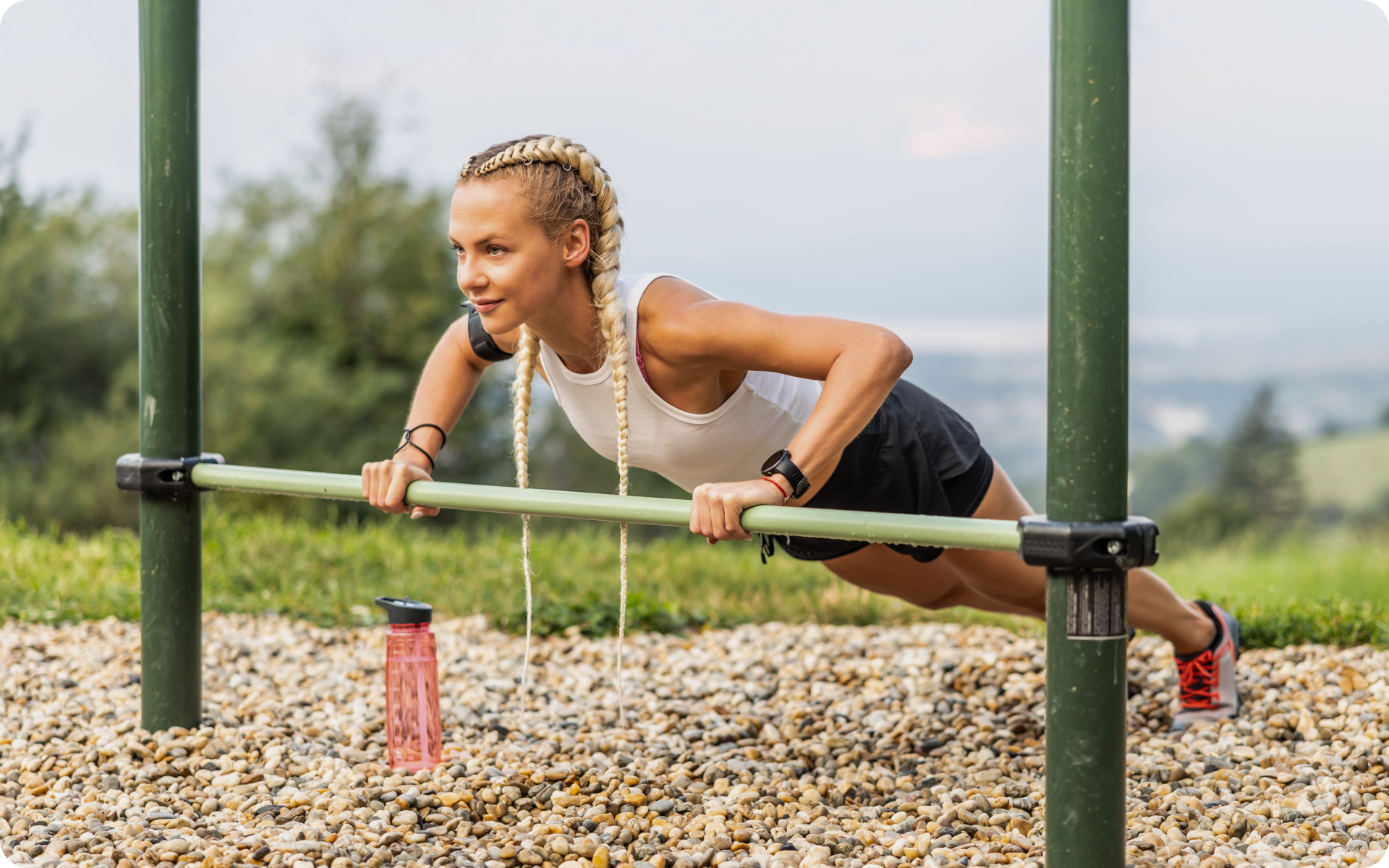The benefits of at-home calisthenics cannot be understated. Research has shown that these bodyweight exercises can increase strength. These factors can also help to reduce the risk of injury (5).
Performing these exercises at home is convenient because it saves you time and money on gym memberships, but it can also allow for a more personalized workout routine. In addition, you’ll have the freedom to work out whenever suits your schedule.
Now, what exactly do you need to build your perfect gym at home? From pull-up bars to parallettes, the world of calisthenics equipment may seem overwhelming at first.
This guide will help you navigate through the essentials so you invest in the right tools to effectively enhance your home workouts.
What Equipment Do You Need for Calisthenics at Home?
Calisthenics may just be bodyweight exercises, but having the right equipment can take your workouts to a whole new level.
Here are some of the must-haves for your home gym:
Pull-Up Bar (Upper-Body Strength)
Pull-up bars, a staple of calisthenics equipment for beginners, are incredible for building upper-body stren as gth. This piece of calisthenics equipment is used for performing the classic pull-up exercise, working out your back, arms, and shoulders.
It’s versatile enough for a range of exercises, such as chin-ups and hanging leg raises, which makes it great for a calisthenics workout for abs too.
Pull-up bars can easily be mounted in doorways or on walls, which makes them a great option for a calisthenics garden or outdoor exercise spot.
Parallettes (Full Body Workout)
Next up are parallettes. These are essentially low parallel bars that provide a full-body calisthenics workout. They can work your core, flexibility, and balance, making them perfect for both beginners and advanced practitioners.
They allow for various exercises such as push-ups, dips, L-sits, and handstand push-ups. This equipment is part of the cheap calisthenics equipment for home and can be stored easily for use indoors or outdoors, which makes it a staple in any calisthenics equipment kit.
Dip Station (Chest and Tricep Strength)
A dip station is another piece of crucial calisthenics equipment. It’s perfect for strengthening the chest and triceps with exercises such as tricep dips and chest dips, which makes it a part of the weighted calisthenics regime.
This tool can be used in the comfort of your home or as outdoor calisthenics equipment, offering versatility and convenience.
Gymnastic Rings (Versatile Full Body Workout)
Gymnastic rings hung from a ceiling or a bar offer an incredibly versatile workout. They add a whole new level of intensity to your calisthenics routine.
You can perform a variety of exercises, such as ring rows, pull-ups, push-ups, dips, and muscle-ups, all of which are part of the calisthenics list of exercises. Their flexibility makes them one of the best tools for a well-rounded home gym.
Whether you’re looking to simply pep up your fitness routine, jazz up your diet with mouth-watering low-calorie recipes or want to get your act together and significantly drop that number on your scale – BetterMe app has got you covered! Improve your body and revamp your life with us!
Jump Rope (Cardio and Agility)
A jump rope may seem basic, but it’s a powerful piece of calisthenics equipment. It’s perfect for cardio workouts and improving agility and is easy to store and use anywhere, indoors, or outdoors.
A jumping rope can warm you up for more intense exercises or serve as high-intensity interval training on its own. It’s an essential part of any calisthenics equipment kit and a great starting point for beginners.
Resistance Bands (Enhance Flexibility and Strength)
Resistance bands are calisthenics equipment for both beginners and pros. These simple yet effective tools offer a variety of resistance levels to add an extra challenge to your calisthenics exercises. They can help enhance flexibility, strength, and muscle tone.
Due to their compact nature, resistance bands can easily be part of your calisthenics equipment kit and can be used anywhere, which makes them perfect for a calisthenics equipment garden or other outdoor workout space.
Furthermore, they’re among the cheap calisthenics equipment for home, so they won’t break the bank.
Push-Up Bars (Chest and Arm Strength)
Push-up bars are another wonderful addition to your calisthenics equipment for home. They add depth to your push-ups, increasing the intensity of each rep by working through a greater range of motion. This can result in greater strength and definition in the chest and arms. They are also perfect for a calisthenics workout for abs.
These bars are light, portable, and a great component of a calisthenics equipment outdoor setup. They’re also cheap calisthenics equipment for home, which makes your fitness journey affordable.
Wall Balls (Full Body Workout)
Wall balls are versatile tools for a full-body workout, so they are a worthy addition to your calisthenics equipment for home. These weighted balls can be used in a multitude of exercises, including squats, lunges, and overhead throws, all of which are part of the calisthenics list of exercises.
They can also be incorporated into a weighted calisthenics routine for added intensity. Wall balls can be used indoors or outdoors, extending your calisthenics equipment garden workout potential.
Ab Wheel (Core Strength)
An ab wheel is a must-have for any calisthenics equipment kit if your aim is to develop core strength. It offers a challenging core workout, which helps build strong abs and lower-back muscles.
The ab wheel is a compact and affordable tool and is part of the list of cheap calisthenics equipment for home. It’s easy to use, which makes it great calisthenics equipment for beginners, and it can easily be incorporated into a calisthenics workout for abs.
Sandbags (Weighted Calisthenics)
Sandbags are an unusual yet effective piece of calisthenics equipment for home. They’re a form of weighted calisthenics that can be used to add resistance to your workouts.
Sandbags can be used for a variety of exercises, including squats, lunges, and throws, which will broaden your list of calisthenics exercises. They can be used as part of a calisthenics equipment outdoor setup, which will allow you to enjoy your workouts in the fresh air.
Read more: 10 Calisthenics for Shoulders Exercises: Enhance Your Strength and Mobility
Battle Ropes (Cardio and Toning)
Battle ropes offer an awesome addition to your calisthenics equipment for home. You may have seen them, anchored at one end, while you wave, slam, or whip the ropes to get your heart pumping.
Battle ropes provide a high-intensity, full-body workout and they are perfect for cardio and toning. They are commonly used in intervals, in combination with other calisthenics exercises, for maximum effect. They are portable and can be used as a part of your calisthenics equipment outdoor setup.
Medicine Balls (Full Body Strength)
Medicine balls are a versatile and effective addition to your calisthenics equipment for home. These weighted balls can be thrown, caught, lifted, or used in a variety of exercises such as squats, lunges, and overhead presses, which makes them part of the weighted calisthenics arsenal.
A medicine ball is also suitable for a calisthenics workout for abs when it is used in exercises such as Russian twists or medicine ball slams.
Suspension Trainer (Full Body Workout)
A suspension trainer is an affordable and versatile tool you can add to your calisthenics equipment for home. This portable training tool leverages gravity and your body weight to enable you to perform hundreds of exercises.
You’re in control of how much you want to challenge yourself on each exercise as you can simply adjust your body position to add or decrease resistance.
Plyo Box (Power and Agility)
A plyo box is an essential part of your calisthenics equipment for home if you’re looking to improve power and agility. These boxes are used for plyometric training, which involves exercises where you jump, bind, and hop to build explosive power and speed.
Exercises such as box jumps and step-ups are common additions to the calisthenics list of exercises if you have a plyo box.
Weighted Vest (Resistance Training)
A weighted vest adds an extra layer of intensity to your calisthenics workouts. It adds additional load to your body, which increases the resistance your muscles work with.
It is a versatile tool that can be used for a large range of exercises, from squats to pull-ups, and it can also turn a walk in the park into a solid workout. It is also portable and can be used as part of your calisthenics equipment outdoor setup.
Can I Get Fit With Just Calisthenics?
Yes, it’s possible to get fit with just calisthenics. Consistently practicing this form of exercise can help improve cardiovascular health, build strength, enhance flexibility, boost coordination, and promote body control.
Elevating Cardiovascular Health
One of the first areas where you’ll notice a change when you start calisthenics is your cardiovascular health. Exercises such as jumping jacks and burpees get your heart rate up faster than you can say “cardio”.
These exercises help strengthen your heart while also improving your endurance, which means you can handle longer, more intense workouts over time.
Building Muscular Strength
Calisthenics also does wonders for your muscular strength. Think about it: every time you do a push-up or a squat, you’re lifting your own body weight. All these push-ups, squats, and pull-ups can help build lean muscle and improve your l strength over time (5).
In addition, as these exercises engage multiple muscle groups simultaneously, you’ll get a comprehensive workout that tones and strengthens your entire body (5).
Enhancing Flexibility
Don’t forget about flexibility. The dynamic nature of calisthenics exercises, such as lunges or high kicks, helps enhance your flexibility and range of motion.
This increased flexibility can help prevent injuries, improve your posture, and contribute to better performance in other sports and physical activities (c).
Boosting Coordination and Balance
Calisthenics exercises often involve compound movements that require a great deal of coordination and balance. For example, a pistol squat requires leg strength and a good deal of balance and control.
As you continue practicing these movements, your coordination and balance will inevitably improve, which canl contribute to better overall physical performance (4).
Promoting Body Control
Finally, calisthenics promotes body control. This type of training allows you to get in tune with your own body and understand how to control its movements and use its strength most efficiently.
You’ll find that with time, you’ll become more efficient when performing movements in both your workouts and in everyday life.
If you struggle to even flirt with the idea of giving up your favorite foods or working out till your legs give way – BetterMe app is here to breathe a fresh perspective into the way you view the weight loss process! Check out the app and experience the fun side of fitness and dieting with BetterMe!
Can I Do Calisthenics Instead of Gym?
There’s no reason not to swap the gym for calisthenics. In fact, many people are turning to this form of exercise as an alternative to traditional gym workouts.
Calisthenics can offer many of the same benefits you get from using weights and machines at the gym, with the added bonus of being able to do it anywhere – including in your own home or outdoor space.
Both calisthenics and gym workouts can help build muscle, improve cardiovascular health, and help with weight loss. The key difference is that calisthenics is reliant on your body weight as resistance, whereas the gym offers various equipment and weights to achieve results.
The gym is good for those who want to focus on specific muscle groups and have access to specialized equipment. However, calisthenics offers a more functional approach and challenges your entire body in a more dynamic way.
How Should a Beginner Start Calisthenics?
The ideal starting point for beginner calisthenics is learning and mastering the basics, including fundamental movements such as push-ups, pull-ups, squats, and lunges.
Start by mastering the proper form and technique for these exercises before you move on to more advanced variations.
It’s important to note that a calisthenics beginner isn’t always a beginner to fitness, so you may have an idea of how to execute these fundamental movements. If this is the case, don’t be afraid to push yourself and try more challenging variations or combinations.
Exercise intensity should remain low at first – don’t worry about the number of reps or sets you are performing. You should focus on perfecting your form and technique while gradually increasing the intensity as you become more comfortable with the movements.
How Can I Start Calisthenics At Home?
To start calisthenics at home, you should follow these simple steps:
Find a Suitable Space
Make sure you have enough room to perform exercises without any obstructions.
Invest in Basic Equipment
While calisthenics can be done without equipment, having essentials such as a pull-up bar, resistance bands, and possibly a plyo box or weighted vest can add variety and intensity to your workouts.
Warm-up
As with any workout, warming up your muscles before diving into the exercises is essential. Try some light cardio and dynamic stretches to get your blood flowing and prepare your body for the workout (7).
Start With the Basics
Start with fundamental movements such as push-ups, pull-ups, squats, and lunges, mastering proper form and technique before you move on to more advanced variations.
Incorporate Leg, Core, and Cardio Exercises
To achieve a well-rounded calisthenics routine, make sure you include exercises that target your legs, core, and cardiovascular system.
Don’t Forget About Rest Days
As with any exercise regimen, incorporating rest days into your schedule to allow your muscles to recover and prevent injury is essential (8).
Read more: Morning Calisthenics: Kickstart Your Day With a Powerful Routine
Frequently Asked Questions
Is 20 minutes of calisthenics enough?
20 minutes of calisthenics can be enough if you’ve mastered proper form and technique and you execute the movements correctly to target the right muscle groups.
You may also need to look into how intensely you perform the exercises and adjust them accordingly. Depending on your goal, you may want to increase the duration or intensity of your workouts.
Is 30 too old for calisthenics?
No, 30 is as good an age as any to start calisthenics. It’s never too late to improve your physical fitness, and calisthenics offers a low-impact, adaptable way to do this. You can tailor your workouts to suit your own abilities and gradually increase the intensity as you progress.
What is the 80/20 rule in calisthenics?
The 80/20 rule, also known as the Pareto principle, suggests that 80% of your results come from 20% of your efforts (3).
In the context of calisthenics, this means that a small number of key exercises (such as push-ups, pull-ups, and squats) are responsible for the majority of your strength and fitness gains.
Why are calisthenics guys so strong?
Calisthenics participants are often incredibly strong as their workouts involve compound movements that engage several muscle groups at once.
This functional fitness approach, compounded by the use of body weight as resistance and advanced movements, helps them build significant strength, flexibility, and endurance.
Which is better, calisthenics or gym?
Both calisthenics and traditional gym workouts have unique benefits. Calisthenics offers a functional fitness approach where body weight is used as resistance, which can promote flexibility, coordination, and body awareness.
At the same time, gym workouts allow for targeted muscle group training and make tracking strength progression easier. The best choice should be influenced by your individual fitness goals and personal preferences.
Does calisthenics build muscle?
Yes, calisthenics can help build muscle.
The resistance training that is involved in calisthenics exercises can promote muscle growth and strength in a similar way to traditional weightlifting (1). However, it’s important to remember that diet and rest are also crucial components of any muscle-building regimen.
Is calisthenics as effective as weightlifting?
Calisthenics can be as effective as weightlifting for certain outcomes. Both are forms of resistance training that can promote muscle growth, strength, and endurance (6). While weightlifting may allow for faster, more easily measurable progression, calisthenics can offers a more functional, full-body workout.
The Bottom Line
Although calisthenics is a simple form of exercise that requires minimal equipment, having some home gym equipment can add variety and intensity to your workouts. Proper form, technique, and progression are a great starting point for beginners.
DISCLAIMER:
This article is intended for general informational purposes only and does not serve to address individual circumstances. It is not a substitute for professional advice or help and should not be relied on for making any kind of decision-making. Any action taken as a direct or indirect result of the information in this article is entirely at your own risk and is your sole responsibility.
BetterMe, its content staff, and its medical advisors accept no responsibility for inaccuracies, errors, misstatements, inconsistencies, or omissions and specifically disclaim any liability, loss or risk, personal, professional or otherwise, which may be incurred as a consequence, directly or indirectly, of the use and/or application of any content.
You should always seek the advice of your physician or other qualified health provider with any questions you may have regarding a medical condition or your specific situation. Never disregard professional medical advice or delay seeking it because of BetterMe content. If you suspect or think you may have a medical emergency, call your doctor.
SOURCES:
- Bodyweight Training: A Return To Basics (2010, journals.lww.com)
- Flexibility (n.d., physio-pedia.com)
- The 80/20 Rule And How It Can Change Your Life (2016, forbes.com)
- The Effect of Breaking Up Sedentary Time with Calisthenics on Neuromuscular Function: A Preliminary Study (2022, mdpi.com)
- The effects of a calisthenics training intervention on posture, strength and body composition (2017, researchgate.net)
- Evidence-Based Resistance Training Recommendations (2011, researchgate.net)
- Warm-Up Strategies for Sport and Exercise: Mechanisms and Applications (2015, pubmed.ncbi.nlm.nih.gov)
- Why Rest Days Are Important for Muscle Building (log.nasm.org)
